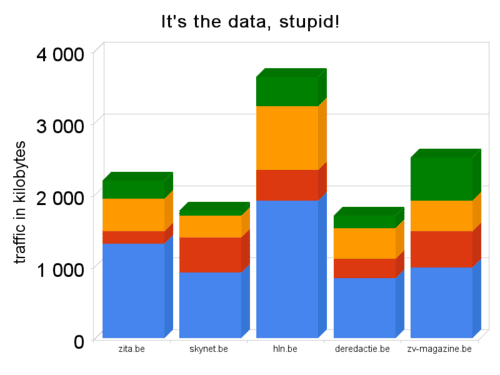 Last week’s prediction about Flash becoming irrelevant was pretty controversial, and some of you Flashheads had interesting remarks and -rhetorical- questions both in the comments and on Twitter (a big shout-out to Clo Willaerts for sharing). So without further ado, here’s my follow-up.
Last week’s prediction about Flash becoming irrelevant was pretty controversial, and some of you Flashheads had interesting remarks and -rhetorical- questions both in the comments and on Twitter (a big shout-out to Clo Willaerts for sharing). So without further ado, here’s my follow-up.
Flash isn’t evil
Some people seemed all too happy to dismiss my post as being plain old Flash-bashing. Sorry to disappoint you, but I”m not saying Flash is evil or that it will (or should) disappear altogether. Next correction: I do have Flash player installed and in general I do know if a application is made in Flash or not. Heck, the web has been my job for more than 10 years now and Flash has been a point of interest for quite some time already. And yes, there indeed are innovative web applications and games that are build in Flash. That being said, I do think (because of accessibility, SEO and some more philosophical reasons) it’s best to avoid using Flash to develop a site’s core functionality if the same can be achieved with non-propriety, standard web technology.
It’s not about Flash vs HTML5
The comments on last week’s blogpost seemed to focus very much on the individual merits (or lack thereof) of HTML5, CSS3 or Canvas, as if these are islands with no history and no connections to the web mainland. This is, off course, wrong; these “new” technologies just happen to be the most recent evolutions of the core components of the rapidly evolving ecosystem that is the “open web”. Moreover, with HTML, CSS and Javascript being the brick and mortar, libraries such as JQuery, Dojo and YUI are the “prefab” building blocks of open web development, offering plug&play components to efficiently build cross-browser rich web interfaces. So the discussion is not about Flash vs HTML5, but about the choice between Flash and the powerful “open web technology stack”.
about:evolution
“The only constant is change” and that’s all the more valid on the web. Flash has an important role to play in this respect, having pushed the boundaries of web-based UI’s for many years. But as some of the cutting-edge features that once were only available in Flash, can now be created more efficiently using non-propriety technology, there’s a shift towards the use of those open web components (e.g. the Flash carousel on National Geographic website that was shown in the Adobe video from my previous post has been replaced by a JQuery implementation).
I believe (and that’s what the previous post was about) this trend will continue in 2010 because of features of HTML5, CSS3, canvas, … becoming available to a wider audience either natively (in new browsers) or through libraries that provide cross-browser compatible implementations. And yes, I’m afraid that in my book that means Flash will become less relevant (“irrelevant” in my previous post being an obvious hyperbole).
Loose ends & examples
- The <video> codec problems Serge fears can -and should- be easily hidden from end-users (as Apple does for example). Moreover the patent-related codec-issue will, I predict, be solved in 2010 with Google acquiring On2 Technologies and putting at some (if not all) of the codecs (VP3 was the basis of Theora, VP6 is in Flash 8 Video and JavaFX) in the public domain
- <Canvas> is already in the wild and doing just fine, thanks for asking Stefan. Major webapps with great graphical UI’s such as 280slides, Mindmeister, Bespin, Google Maps and Yahoo Pipes depend on it. Cufon, JQuery visualize and Dojo GFX use it as well and yes, Canvas can be implemented cross-browser (even in IE6) thanks to the explorercanvas library (and with Microsoft actively participating in the discussions about the canvas-spec, one could expect MS to one day release a browser that has native canvas-support)
- Despite great efforts by Adobe, Flash on the mobile web (i.e. in a browser, non-browser implementations are irrelevant in the discussion about “open web vs flash”) remains almost non-existent. The fact that Apple continues to refuse Flash for the iPhone only makes this worse, due to the seemingly untouchable “game-changer” status of their phone and due to the fact that more than 60% of all mobile pageviews originate from their mobile devices.
To sum it all up: when Adobe Flash evangelist Serge writes “Flash Player has it’s place on the web today and in the future” I can only agree. But I’ll bet you that place in the future will be less prominent than the one it holds today.
![]() That’s why I decided to switch from the iPhone-centric WPTouch (which I installed only 3 months ago) to “WordPress Mobile Pack” for this blog. WMP offers great mobile functionality out of the box;
That’s why I decided to switch from the iPhone-centric WPTouch (which I installed only 3 months ago) to “WordPress Mobile Pack” for this blog. WMP offers great mobile functionality out of the box; But let there be no doubt; it’s a great handset! My Hero sports a beautiful touch-screen, a nice -albeit young-
But let there be no doubt; it’s a great handset! My Hero sports a beautiful touch-screen, a nice -albeit young- 
